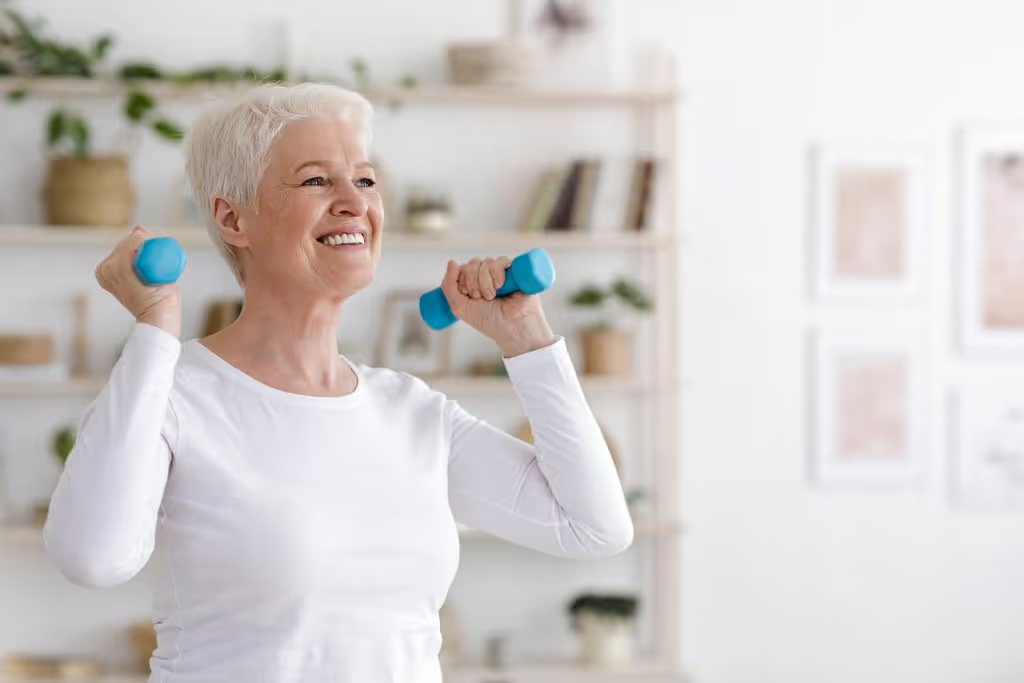
For many individuals, one of the most bothersome things about aging is aches and pains. Undoubtedly, joint pain stands out amongst them. What makes joint pains worse is that they significantly impact your ability to move. Mere walking, standing, or even sitting can become painful. Interestingly, most of the issues related to bones, joints, and muscles originate because of disuse. In the UAE itself, a large percentage of people over 65 years of age, suffer from one or the other joint related issue, most prevalent being osteoarthritis. Overall, the incidence of bone and joint problems peaks with advancing age, especially around the ages of 65-80 years. With age, our bones naturally tend to lose density and joints get stiffer and lose their flexibility. However, it is never too late to start a joint-healthy routine!
Exercises can prove to be the best way to improve your joint health. Contrary to popular belief, exercises will not make your joints trouble more. In fact, it will ensure that you do not lose your muscle mass over time. Putting your body at work will not only strengthen your bones, but will reduce the rate of bone loss.
For better joint health, it is important to engage in light, low-impact exercises. High-impact exercises can do more harm than good. Such exercises exert a lot of stress on your joints, which can result in the wearing of your joints and cartilages. Activities such as walking, yoga, and swimming can do wonders for your joints as well as to your heart and overall health.
Your joints are bearing all your body weight. Just think of the pressure the joints in your knees, hips, and spine have to keep up to. And if you are overweight, then do not forget the excess strain you are putting on your joints. Yes, it can be difficult to attain a slim figure at this age, however, one can always stay at a healthy weight. The importance of maintaining a lighter weight cannot be stressed enough. In the beginning, you can start with controlling the oily or unhealthy foods you eat, and some physical activities. Healthy lifestyle changes, like sleeping patterns and general body postures, can help you lose those extra pounds. Remember to not indulge in crash dieting or sudden heavy exercise routines. Get rid of the extra weight in a healthy way for sustained results.
Stretching is an excellent way of maintaining joint flexibility. Stretching is believed to release muscle tension. If your muscles are strong and in good shape, then they can protect your joints and avoid the risk of injuries. Stretch in the morning, before going to bed, before starting a workout, after finishing one, and even on days when you do not exercise. Benefits of stretching include improved posture, increased blood circulation and muscle control, reduced risk of injury, and releasing of soreness and tension from muscles, especially helpful to the elderly.
Unfortunately, many people do not pay much attention to their posture while sitting or standing. Yet, your body posture does have a major role to play. With age, the daily routine tends to become less active and people end up lazing around a bit more, resulting in bad postures. Because of incorrect posture, people suffer pain in their joints, neck, and spine. One should ensure the right posture not only while sitting or standing, but also while lifting or carrying even the lightest weight. You can try working on your core muscles. This will help in improving your posture naturally.

Unfortunately, many people do not pay much attention to their posture while sitting or standing. Yet, your body posLifting very light weights or doing strength training can increase and strengthen your muscles. It can also aid in maintaining bone mass. Working on your body strength can improve your mobility, flexibility, and stability. For elders, it is wise to choose and stay with lighter weights, especially if you are exercising without any trainer. It is more important to consult a doctor before getting into weight training. Make sure to perform slow and controlled movements. If possible, get yourself a trainer. ture does have a major role to play. With age, the daily routine tends to become less active and people end up lazing around a bit more, resulting in bad postures. Because of incorrect posture, people suffer pain in their joints, neck, and spine. One should ensure the right posture not only while sitting or standing, but also while lifting or carrying even the lightest weight. You can try working on your core muscles. This will help in improving your posture naturally.
Slight healthy changes in your lifestyle can help you keep your joints and bones well-conditioned. That being said, it is wise for the elderly to first consult their doctor before incorporating these habits into the routine. You do not want to go wrong. And remember, no matter how fit you may consider yourself to be, a little exercise and good food is always a great idea.
Consuming nutrition-rich food is essential even if your joints and bones are in good shape. Nevertheless, if you suffer from joint pain because of inflammatory arthritis or osteoporosis, incorporating these foods into your routine may help with your joint health.
